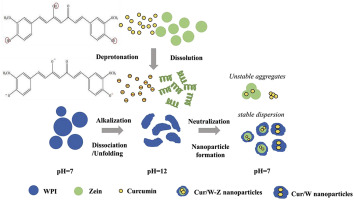当前位置:
X-MOL 学术
›
Food Hydrocoll.
›
论文详情
Our official English website, www.x-mol.net, welcomes your
feedback! (Note: you will need to create a separate account there.)
Entrapment of curcumin in whey protein isolate and zein composite nanoparticles using pH-driven method
Food Hydrocolloids ( IF 11.0 ) Pub Date : 2020-09-01 , DOI: 10.1016/j.foodhyd.2020.105839 Xinyu Zhan , Lei Dai , Liang Zhang , Yanxiang Gao
Food Hydrocolloids ( IF 11.0 ) Pub Date : 2020-09-01 , DOI: 10.1016/j.foodhyd.2020.105839 Xinyu Zhan , Lei Dai , Liang Zhang , Yanxiang Gao

|
Abstract In this study, encapsulation strategy of curcumin was employed by fabricating protein-based composite nanoparticles with hydrophilic whey protein isolate (WPI) and hydrophobic zein using an alcohol-free pH-driven method. The mass ratio of WPI to zein had a great effect on WPI and zein composite properties. At the WPI to zein mass ratio of 8:2, the resulting composite nanoparticles showed a relatively small size (about 90 nm). The composite nanoparticles significantly enhanced the solubility of curcumin to be above 0.65 mg/mL and exhibited desirable storage and physical stability as well as re-dispersibility. The presence of zein significantly improved thermal stability of the composite nanoparticles and the retention rate of curcumin at a high temperature (80 °C) compared to single WPI only. X-ray diffraction confirmed that curcumin was present in an amorphous state inside the nanoparticles. Fourier transform infrared analysis revealed that hydrophobic attraction and hydrogen bonding were the major forces involved in the formation of the composite nanoparticles. Both the pH-potential curve and the transmission electron microscope images revealed that the composite nanoparticles had a core-shell structure with the zein core and WPI shell. The formation mechanism of the composite nanoparticles was also proposed. The composite nanoparticles fabricated by the simple, safe and cost-effective pH-driven method interpreted the potential for delivery of curcumin.
中文翻译:

使用pH驱动方法在乳清分离蛋白和玉米醇溶蛋白复合纳米颗粒中包埋姜黄素
摘要 在本研究中,采用无醇 pH 驱动方法制备具有亲水性乳清分离蛋白 (WPI) 和疏水性玉米醇溶蛋白的蛋白质基复合纳米颗粒,采用姜黄素的包封策略。WPI与玉米蛋白的质量比对WPI和玉米蛋白复合物的性能有很大影响。在 WPI 与玉米蛋白质量比为 8:2 时,所得复合纳米颗粒显示出相对较小的尺寸(约 90 nm)。复合纳米颗粒显着提高了姜黄素的溶解度,达到 0.65 mg/mL 以上,并表现出理想的储存和物理稳定性以及再分散性。与仅使用单一 WPI 相比,玉米醇溶蛋白的存在显着提高了复合纳米粒子的热稳定性和姜黄素在高温 (80 °C) 下的保留率。X 射线衍射证实姜黄素在纳米粒子内部以无定形状态存在。傅里叶变换红外分析表明疏水吸引力和氢键是复合纳米粒子形成的主要作用力。pH-电位曲线和透射电子显微镜图像均显示复合纳米粒子具有核壳结构,具有玉米醇溶蛋白核和 WPI 壳。还提出了复合纳米粒子的形成机理。通过简单、安全和具有成本效益的 pH 驱动方法制造的复合纳米粒子解释了姜黄素的传递潜力。傅里叶变换红外分析表明疏水吸引力和氢键是复合纳米粒子形成的主要作用力。pH-电位曲线和透射电子显微镜图像均显示复合纳米粒子具有核壳结构,具有玉米醇溶蛋白核和 WPI 壳。还提出了复合纳米粒子的形成机理。通过简单、安全和具有成本效益的 pH 驱动方法制造的复合纳米粒子解释了姜黄素的传递潜力。傅里叶变换红外分析表明疏水吸引力和氢键是复合纳米粒子形成的主要作用力。pH-电位曲线和透射电子显微镜图像均显示复合纳米粒子具有核壳结构,具有玉米醇溶蛋白核和 WPI 壳。还提出了复合纳米粒子的形成机理。通过简单、安全和具有成本效益的 pH 驱动方法制造的复合纳米粒子解释了姜黄素的传递潜力。还提出了复合纳米粒子的形成机理。通过简单、安全和具有成本效益的 pH 驱动方法制造的复合纳米粒子解释了姜黄素的传递潜力。还提出了复合纳米粒子的形成机理。通过简单、安全和具有成本效益的 pH 驱动方法制造的复合纳米粒子解释了姜黄素的传递潜力。
更新日期:2020-09-01
中文翻译:

使用pH驱动方法在乳清分离蛋白和玉米醇溶蛋白复合纳米颗粒中包埋姜黄素
摘要 在本研究中,采用无醇 pH 驱动方法制备具有亲水性乳清分离蛋白 (WPI) 和疏水性玉米醇溶蛋白的蛋白质基复合纳米颗粒,采用姜黄素的包封策略。WPI与玉米蛋白的质量比对WPI和玉米蛋白复合物的性能有很大影响。在 WPI 与玉米蛋白质量比为 8:2 时,所得复合纳米颗粒显示出相对较小的尺寸(约 90 nm)。复合纳米颗粒显着提高了姜黄素的溶解度,达到 0.65 mg/mL 以上,并表现出理想的储存和物理稳定性以及再分散性。与仅使用单一 WPI 相比,玉米醇溶蛋白的存在显着提高了复合纳米粒子的热稳定性和姜黄素在高温 (80 °C) 下的保留率。X 射线衍射证实姜黄素在纳米粒子内部以无定形状态存在。傅里叶变换红外分析表明疏水吸引力和氢键是复合纳米粒子形成的主要作用力。pH-电位曲线和透射电子显微镜图像均显示复合纳米粒子具有核壳结构,具有玉米醇溶蛋白核和 WPI 壳。还提出了复合纳米粒子的形成机理。通过简单、安全和具有成本效益的 pH 驱动方法制造的复合纳米粒子解释了姜黄素的传递潜力。傅里叶变换红外分析表明疏水吸引力和氢键是复合纳米粒子形成的主要作用力。pH-电位曲线和透射电子显微镜图像均显示复合纳米粒子具有核壳结构,具有玉米醇溶蛋白核和 WPI 壳。还提出了复合纳米粒子的形成机理。通过简单、安全和具有成本效益的 pH 驱动方法制造的复合纳米粒子解释了姜黄素的传递潜力。傅里叶变换红外分析表明疏水吸引力和氢键是复合纳米粒子形成的主要作用力。pH-电位曲线和透射电子显微镜图像均显示复合纳米粒子具有核壳结构,具有玉米醇溶蛋白核和 WPI 壳。还提出了复合纳米粒子的形成机理。通过简单、安全和具有成本效益的 pH 驱动方法制造的复合纳米粒子解释了姜黄素的传递潜力。还提出了复合纳米粒子的形成机理。通过简单、安全和具有成本效益的 pH 驱动方法制造的复合纳米粒子解释了姜黄素的传递潜力。还提出了复合纳米粒子的形成机理。通过简单、安全和具有成本效益的 pH 驱动方法制造的复合纳米粒子解释了姜黄素的传递潜力。











































 京公网安备 11010802027423号
京公网安备 11010802027423号